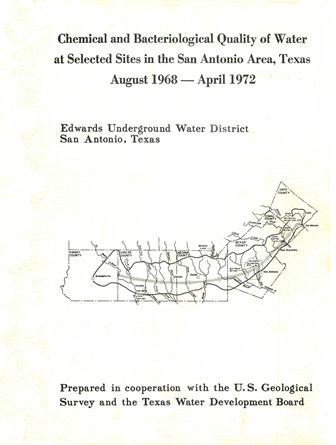Chemical and Bacteriological Quality of Water at Selected Sites in the San Antonio Area, Texas August 1968-April 1972

| Author | Reeves RD, Rawson J and Blakey JF (US Geological Survey, in cooperation with the Edwards Underground Water District and the Texas Water Development Board) |
| Year | 1972 |
| Description | Surface and groundwater quality monitoring in the San Antonio area, 1968-1972 |
| Publisher | Edwards Underground Water District |
| Location | Edwards Aquifer, Balcones Fault Zone, San Antonio Segment, and associated surface water |
| Cover | View Download |
| File | View Download |
| Summary |
|
Urban development on or adjacent to the recharge zone of the Edwards aquifer is causing concern about the possible pollution of ground water in the aquifer, which is the principal source of water supply for the San Antonio area. Water-quality data for many wells and springs and for selected sites on streams that cross the recharge zone of the aquifer are being collected to provide background information and to detect any current pollution of ground water in the area. Water from the Edwards aquifer is very hard and of the calcium bicarbonate type. The concentrations of dissolved solids in samples from wells and springs ranged from about 200 to 470 mg/1 (milligrams per liter); the chloride and sulfate concentrations ranged from 6.5 to 62 mg/1 and from 0.0 to 65 mg/1, respectively. The nitrate and phosphate contents of the ground water ranged from 0.0 to 15 mg/1 and from 0.00 to 0. 37 mg/1. The concentrations of these and other constituents show that the chemical quality of water in the Edwards aquifer has not been degraded significantly by domestic, industrial, or agricultural effluents. However, variations in the number of coliforms, the concentrations of nitrate and phosphate, and the presence of fecal coliforms and fecal streptococci in samples from some wells show that fecal pollution is reaching the aquifer. Most of these wells, which are located in or just downdip from the recharge zone, are poorly sealed or inadequately cased. The areal variation in the locations of these wells indicates that pollution of ground water in the aquifer is very localized. Pollution results principally from runoff from the land surface and from effluent from septic tanks which enters the aquifer through fractures in the recharge zone or which infiltrates through the thin soil into poorly sealed or inadequately cased wells in or adjacent to the recharge zone. Trace amounts of several pesticides have been detected in samples from two wells in the San Antonio area. Field investigations showed the source of pesticides in these wells to be. surface drainage that entered the wellbores. Water-quality data collected at sites on streams that cross the recharge zone of the Edwards aquifer show the chemical composition of surface water to be very similar to that of ground water in the area. Water in most streams is very hard and of the calcium bicarbonate type. Limited data on the bacteriological quality show that coliforms were present at each of the sites sampled and that fecal coliforms and fecal streptococci were present at most sites. Although the number of these bacteria varied greatly in both time and place, their density in samples from most sites were low for untreated surface water. |
Search for Documents
Advance Search
Explore EAA's Scientific Reports
- All Reports
- Groundwater Recharge, Recharge Zone
- Groundwater Movement
- Geomorphology and Caves
- Weather Modification
- Geology
- Water Use and Conservation
- Geochemistry
- Water Resources Planning and Management
- Floods and Drought
- Water Quality
- Climatology
- Surface Water / Groundwater Relationship
- Biology
- Springs, Groundwater Discharge
- Archaeology
- RZ Protection
- Aquifer Levels
- Remote Sensing
- Precipitation
- Overview Studies
- Modeling
- Hydrology and Hydrogeology
- History
